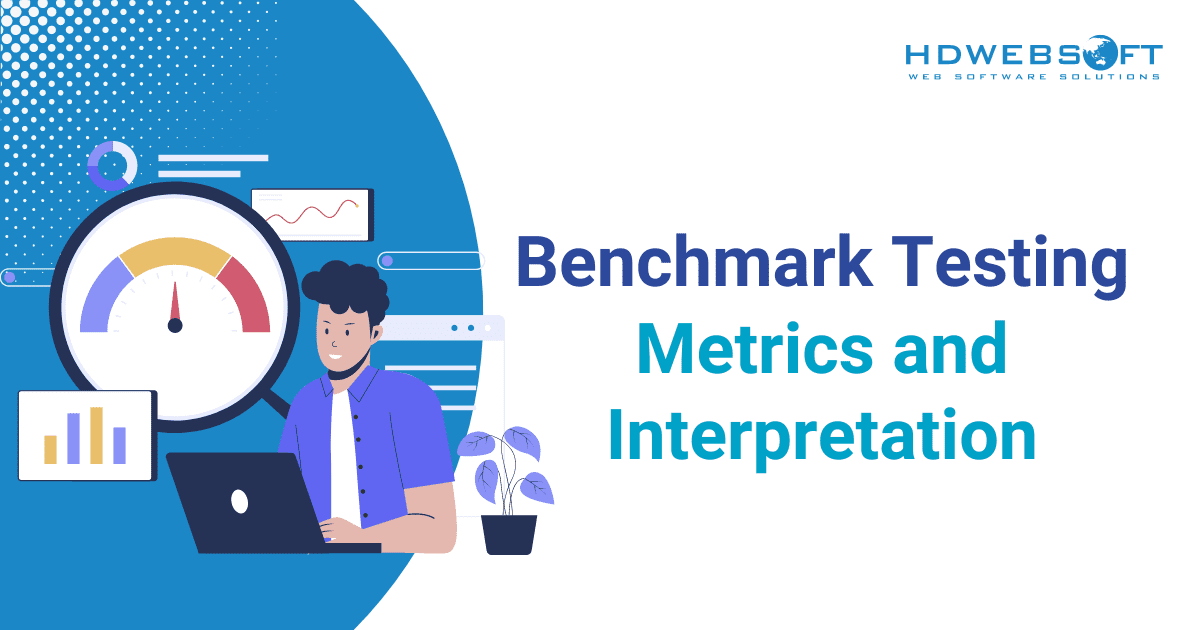
Benchmark Testing Metrics and Interpretation
Benchmark testing plays a crucial role in software testing. It evaluates a software system or component against predefined standards or benchmarks. When considering baseline vs benchmark testing, it’s important to understand that baseline testing establishes your system’s initial performance reference point, while benchmark compares this performance against industry standards or predefined criteria. This targeted approach helps organizations ensure their applications meet expected performance criteria and can handle the anticipated load.
In contrast to broader software testing practices that may focus on functionality or usability, performance benchmarking for applications uses a variety of metrics and measurements to provide a comprehensive assessment of software performance, highlighting areas for improvement and optimization.
In this blog, we will explore four phases of benchmarking, the key metrics involved in the process, and how to interpret the results to enhance software performance.
The Four Phases of Benchmark Testing
Performance benchmarking for applications is a structured approach to evaluating a software system’s performance and capabilities. This process is typically divided into four distinct phases: planning, analysis, integration, and action.
Planning Phase
The planning phase is the foundation of the benchmark testing process. During this stage, objectives are clearly defined, and the scope of testing is established.
Key activities in this phase include identifying the metrics for performance benchmarking for applications to be evaluated, selecting the appropriate benchmarking tools, and setting the benchmarks or performance standards against which the software will be tested. It is crucial to ensure that the objectives align with the overall goals of the organization. Additionally, the selected metrics must be relevant to the software’s intended functionality and user requirements.
Effective planning sets the stage for a smooth and focused testing process, reducing the risk of unexpected issues and ensuring that all necessary resources are available. Notably, 80% of CIOs plan to increase their investment in cybersecurity in 2024, highlighting the growing importance of security metrics in benchmarking efforts
Analysis Phase
Once the planning benchmark testing phase is complete, the process transitions into the analysis phase. In this stage, benchmark tests are executed, designed to mimic real-world user scenarios, which may be influenced by BDD user stories. Afterward, the collected data is meticulously analyzed to identify performance bottlenecks, inefficiencies, and areas where the software does not meet the predefined performance criteria established in the scenarios.
Furthermore, statistical and comparative analysis techniques are employed to interpret the raw data. These techniques provide valuable insights into how well the system performs under the various usage patterns and workloads simulated by the benchmark tests. Consequently, this phase, guided by BDD principles, is essential for understanding the software’s performance in relation to user needs and serves as the foundation for any necessary improvements.
Integration Phase
The integration phase focuses on incorporating the insights gained from the analysis phase into the development and operational processes. This involves integrating performance improvements into the software, optimizing the code, and enhancing system configurations to meet the benchmark standards.
During this phase, it is also essential to ensure that any changes made do not negatively impact other aspects of the software’s functionality. To achieve this, continuous integration practices may be employed to automate the incorporation of these improvements into the software development lifecycle, ensuring that performance enhancements are consistently applied and tested.
Action Phase
The final phase of benchmark testing is the action phase, where the focus shifts to implementing the changes and continuously monitoring the software’s performance.
This phase includes deploying the optimized software into the production environment and conducting regular performance reviews to ensure that the improvements are sustainable. Continuous monitoring helps identify any new performance issues that may arise and provides ongoing assurance that the software continues to meet the established benchmarks.
Additionally, this phase involves documenting the results and lessons learned, which can be invaluable for future performance benchmarking for applications efforts and for maintaining a culture of continuous improvement within the organization.
The Metrics of Benchmark Testing
Benchmarking helps optimize performance and user experience by mimicking real-world use to find bottlenecks and set a performance baseline. Let’s dive into the key metrics that paint a picture of a system’s capabilities.
Performance Metrics
Response Time
This benchmark testing metric measures the time taken for the system to respond to a user’s request, and it is crucial because it directly impacts the user experience. Faster response times, therefore, lead to higher user satisfaction. This is especially important when performing performance benchmarking for applications that are interactive, such as e-commerce apps or video games, where immediate feedback is expected.
On the other hand, slower response times can frustrate users and drive them away.
Throughput
Throughput refers to the number of transactions or operations a system can handle within a specific period. Throughput is a vital metric for assessing an application’s capacity, especially those dealing with high volumes of data or numerous user interactions. Remarkably, high throughput indicates that the system can efficiently manage a large number of tasks simultaneously.
Latency
Latency measures the delay between a request and the beginning of a response. It is critical for applications requiring real-time processing, such as online gaming or financial platforms. Nonetheless, lower latency is essential to ensure smooth and responsive interactions within these applications.
Scalability Metrics
Load Capacity
This metric evaluates the maximum load a system can handle before its performance starts to degrade. Therefore, understanding load capacity helps organizations plan for scalability. By doing so, they can ensure that their systems can accommodate increasing user loads without compromising performance.
Peak Load
Peak load measures the highest level of activity the system can efficiently manage. This benchmark testing metric is crucial for applications expected to experience sudden spikes in user activity, such as e-commerce websites, during major sales events. Therefore, ensuring the system can handle these peak loads prevents crashes and maintains user satisfaction.
Elasticity
Elasticity assesses the system’s ability to adapt to changing loads by scaling resources up or down as needed. This metric for performance benchmarking for applications is particularly important for cloud-based applications, where resource utilization needs to be optimized dynamically based on demand.
Reliability Metrics
Error Rate
The error rate tracks the frequency of errors occurring during operations. Consequently, a low error rate indicates a reliable system. Conversely, high error rates can erode user trust and lead to significant operational issues. This makes it a critical metric to monitor and optimize.
Mean Time Between Failures (MTBF)
MTBF measures the average time elapsed between system failures. As such, it is a key indicator of system reliability. Higher MTBF values signify more reliable systems, which is essential for mission-critical applications where downtime can have severe consequences.
Mean Time to Repair (MTTR)
MTTR indicates the average time required to repair a system after a failure. In other words, shorter MTTR values are preferable as they imply that the system can be quickly restored to normal operations, minimizing downtime and disruption.
Resource Utilization Metrics
CPU Usage
This metric monitors the percentage of CPU capacity used during operations, and high CPU usage can indicate potential bottlenecks that may slow down the system. This is because effective CPU management is crucial, as it ensures that the system runs efficiently without overloading the processor.
Memory Usage
Memory usage tracks the amount of RAM utilized by the system. Even more importantly, efficient memory usage is crucial for maintaining system performance, especially for applications that require substantial memory resources.
Disk I/O
Disk I/O measures the read/write operations on the disk. High disk I/O can impact data access speeds and overall system performance. This is why optimizing disk I/O is important for applications with heavy data processing requirements. It’s one of the important metrics to conduct while performing benchmark testing.
Network Metrics
Bandwidth
Bandwidth assesses the network’s data transfer capacity, a crucial factor for handling data-intensive operations. Without sufficient bandwidth, these operations can experience delays or even data loss.
Packet Loss
Packet loss tracks the number of data packets lost during transmission. Hence, low packet loss is vital for maintaining data integrity and ensuring reliable communication between systems.
Network Latency
Network latency measures the delay in data transmission across the network. Due to this reason, low network latency is crucial for applications requiring real-time communication, such as video conferencing or online gaming.
Notably, when we run benchmark network latency tests, the results may differ in different network connections. Let’s take a look at these sample test results:
Sample 1: Ideal network connections
/Ping Results:
- 32 ms
- 35 ms
- 34 ms
- 33 ms
- 31 ms
- 36 ms
- 32 ms
- 37 ms
- 34 ms
- 35 ms
Average Latency: 34.2 ms/The result shows a low average latency (around 34 ms) with minimal variation between individual ping times, indicating a stable and fast network connection
Sample 2: Network Congestion
/Ping Results:
- 58 ms
- 72 ms
- 45 ms
- 81 ms
- 62 ms
- 105 ms (packet loss)
- 59 ms
- 88 ms
- 48 ms
- 75 ms
Average Latency: 69.3 ms (with 1 packet loss)/Here, the average latency is higher (around 69 ms), with significant variation between ping times. There might also be a packet loss (indicated by a very high ping value), suggesting network congestion or temporary issues affecting data transfer speed.
Sample 3: Long-Distance Connection
/Ping Results:
- 180 ms
- 175 ms
- 182 ms
- 178 ms
- 184 ms
- 179 ms
- 181 ms
- 177 ms
- 183 ms
- 180 ms
Average Latency: 180.2 ms/This result shows a high average latency, around 180 ms, with relatively consistent ping times. This is likely due to the physical distance between your machine and the target server, which could be causing longer data travel times.
How to Interpret Benchmark Test Results
Interpreting benchmark testing results effectively is key to leveraging them for performance improvement. Here are steps to make the most of your benchmark data:
Data Collection and Monitoring
This is the foundation for performance benchmarking for applications. You’ve already defined your goals and run the benchmark tests, gathering a wealth of data on performance metrics like response times, throughput, and resource utilization.
Data Analysis Techniques
Now comes the analysis phase. Here, you’ll employ various techniques to extract insights from the raw data:
- Statistical Analysis: Use statistical methods like standard deviation to identify patterns and outliers that might indicate issues.
- Trend Analysis: Examine how metrics change over time to predict future performance and pinpoint areas needing proactive optimization.
- Comparative Analysis (Optional): If relevant, compare your data against benchmarks or competitor data to determine if your system meets performance expectations.
Visualization of Results
Don’t just rely on raw numbers! Visualizing your data through charts and graphs helps identify trends, outliers, and areas requiring further investigation.
In addition, dashboards and reports are also very helpful. Dashboards and detailed reports can provide stakeholders with an at-a-glance view of performance metrics and areas for improvement.
In fact, companies using real-time data visualization are 71% more likely to experience revenue growth.
Optimization and Retesting
Based on the analysis and visualizations, you’ll gain valuable insights into system performance. This stage involves:
- Identifying Bottlenecks: Pinpoint areas causing performance issues, such as slow database queries or limited network bandwidth.
- Prioritizing Improvements: Focus on areas with the most significant impact on performance based on your findings.
- Implementing Optimizations: Make changes to hardware, software configurations, or code to address the identified bottlenecks.
- Retesting: After implementing optimizations, re-run the benchmark tests under controlled conditions to measure the effectiveness of the changes and ensure improvements are reflected in the performance metrics.
Conclusion
Benchmark testing is a critical practice for ensuring software systems meet performance standards and can handle the expected load efficiently. By focusing on key metrics, organizations can gain a comprehensive understanding of their software’s capabilities. Regardless, interpreting benchmark test results through thorough data collection, analysis, and visualization helps in identifying areas for improvement and implementing effective optimizations.
Ultimately, consistent performance benchmarking for applications and analysis leads to higher quality, more reliable, and better-performing software systems.












